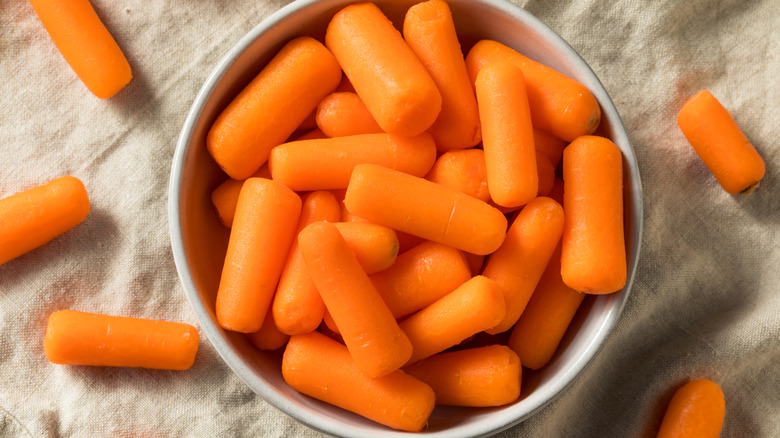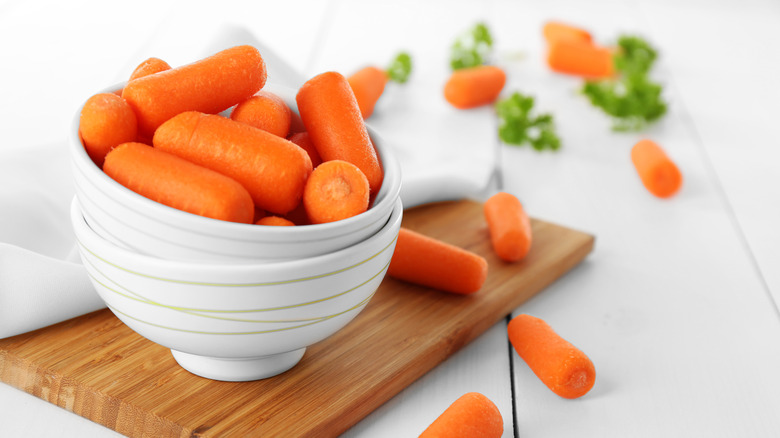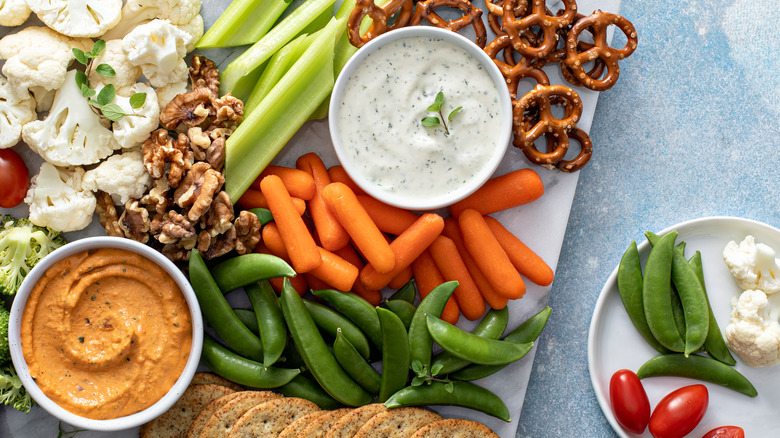How Baby Carrots Are Actually Made
Who doesn't love the convenience and crunch of sweet baby carrots? There is no peeling involved, typically no need for washing, and they're perfect for popping into a container for a healthy snack or lunch on the go. Carrots are certainly much healthier than a snack-size Snickers for satiating your hunger. They're also the perfect veggie for dipping into hummus and are ideal for making mini "not dogs" for vegan pigs in a blanket.
Most of us have heard that the vitamin A in carrots will improve our eyesight, but that's only scratching the surface of the dietary power of this crunchy vegetable. Carrots can also help protect against cancer, assist in lowering cholesterol, and are the perfect food if you're watching your weight due to their ability to make you feel full without adding a lot of calories to your diet (via WebMD).
Useful as they are, those mini baby carrots didn't exist until the 1980s. The story of how they came to be is fascinating, starting with a bright idea from a carrot farmer who didn't want his crop to go to waste.
A farmer's brilliant idea
Many people may think that baby carrots are simply an immature version of grown-up carrots. In reality, they are made from regular-sized carrots that have been cut, peeled, and shaped into their miniature size. The idea for producing baby carrots came from California farmer Mike Yurosek. The thrifty-minded Yurosek didn't want to dispose of all the unusually shaped or blemished carrots that wouldn't make it to produce shelves because of their imperfections. He discovered that a green bean cutting machine was perfect for shaping the ugly carrots into smaller uniform pieces, as USA Today reports. Thus, the baby carrot was born.
The first baby carrots appeared on the market in the mid-1980s. The concept was so popular that, by 1987, carrot sales had soared. Indeed, this tiny form is so popular that most carrots are now sold in baby form (via Washington Post).
Making baby carrots is much more efficient today than when Mike Yurosek first came up with the idea. Carrot processors use one machine for slicing and another for peeling and rounding the ends of the carrots. Any leftover scraps get turned into animal feed, so practically none of the root veggies gets wasted (via Insider).
Mother Nature's nutrition bullets
You may have seen white patches or spots on your baby carrots and wondered if they were safe to eat. The white color occurs because the carrots don't have a protective peel to keep them from drying out. Even if they're not visually perfect, those carrots are completely safe to eat, according to the University of Missouri's Nutrition Busters.
Wild claims have circulated claiming that producers of baby carrots wash them in pesticides or chlorine, but those accusations are simply false. Baby carrots are washed in chlorinated water to kill any dangerous microbes, but the washing solution is entirely harmless, as USA Today reports.
Regular-size carrots may have some health benefits over their petite counterparts, but only if they are left unpeeled. A significant portion of the veggie's fiber is contained in the peel, and lots of free-radical fighting antioxidants are in the skin, too (via Healthline). However, the best vegetable for your body is the one you'll eat. So, if the convenience of baby carrots means you'll eat more of Mother Nature's nutrition bullets, then keep on crunching.


